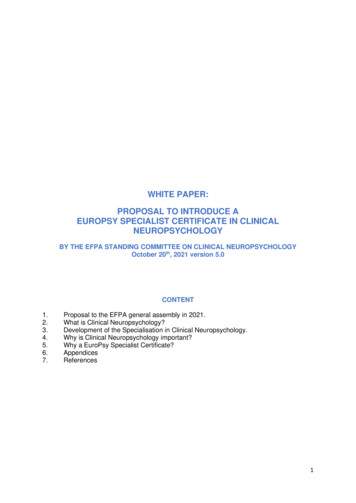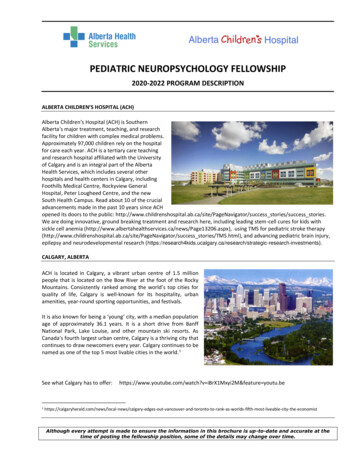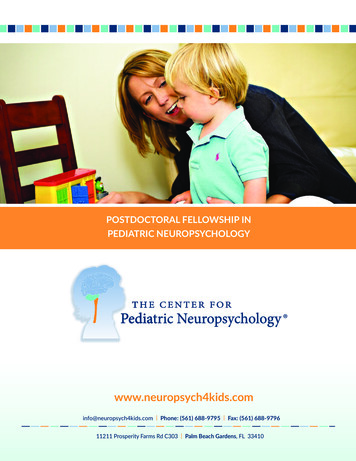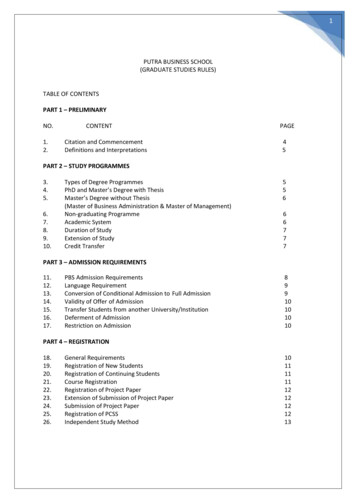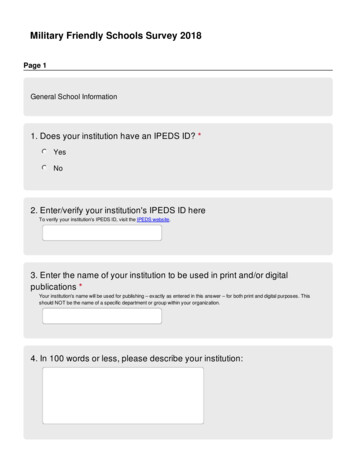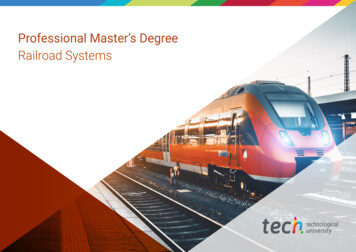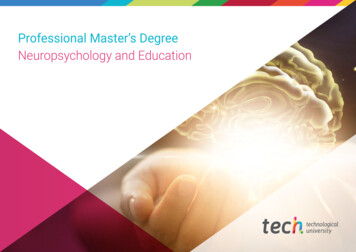
Transcription
Professional Master’s DegreeNeuropsychology and Education
Professional Master’s DegreeNeuropsychology and EducationCourse Modality: OnlineDuration: 12 monthsCertificate: TECH Technological UniversityOfficial Nº of hours: 1,500 h.Website: degree/master-neuropsychology-education
Index0102IntroductionObjectivesp. 4p. 8030405SkillsCourse ManagementStructure and Contentp. 14p. 18p. 220607MethodologyCertificatep. 40p.48
01IntroductionNeuropsychology, in the field of education, is one of the emerging sciences that iscurrently gaining more traction. This behavioral neuroscience is based on the naturalscientific method to approach the study of the brain. Through the combination of thehypothetico-deductive and analytical-inductive methods, the professionals of thisdiscipline develop the therapeutic intervention both in individuals with congenital orsupervening brain lesions as well as in individuals without lesions. This program isdesigned to provide access to the specific knowledge of this discipline, in an intensiveand practical way. A great value for any professional.
Introduction 05In-depth knowledge of neurodevelopment andits multiple implications, in a complete programto propel you to another professional level”
06 IntroductionThe work of neuropsychology in education is complex, it covers a broad spectrumof intervention that requires the professional to have a very specific training, in thevarious branches of brain development. This discipline, deeply linked to neurology andthe physiological study of the brain, is affected by the changes that the evolution ofknowledge in this scientific branch achieves. For professionals, this means an intensechallenge of continuous updating that allows them to be at the forefront in terms ofapproach, intervention and monitoring of the cases that may arise in their practice.Throughout this program, the student will review all the current approaches to the workpracticed by neuropsychologists with regard to the different challenges posed by theirprofession.The functioning of memory, language, the relationship between laterality and cognitivedevelopment, sensoriality and many other aspects, will be the topics of work andstudy that the student will be able to integrate in their training. A high-level step thatwill become a process of improvement, not only on a professional level, but also on apersonal level.This challenge is one of TECH's social commitments: to help highly qualifiedprofessionals to specializae and develop their personal, social and work skills during thecourse of their training.This Professional Master’s Degree in Neuropsychology and Education contains themost complete and up-to-date program on the market. The most important featuresinclude: The latest technology in online teaching software A highly visual teaching system, supported by graphic and schematic contents that areeasy to assimilate and understand Development of practical cases, presented by practising experts State-of-the-art interactive video systems Teaching supported by telepractice Continuous updating and recycling systems Autonomous learning: full compatibility with other occupations Practical exercises for self-assessment and learning verification Support groups and educational synergies: questions to the expert, debate andknowledge forums Communication with the teacher and individual reflection work Availability of the contents from any fixed or portable device with internet connection Complementary documentation banks permanently available, even after the courseNot only does it lead through the theoretical knowledge offered, but it also showsanother way of studying and learning, more organic, simple and efficient. We will workto keep you motivated and to develop in you a passion for learning. We will encoraugeyou to think and develop critical thinking.A program created for professionals whoaspire to excellence and that will allowyou to acquire new skills and strategiesin a smooth and effective way"
Introduction 07A deep and comprehensive diveinto strategies and approaches inNeuropsychology and Education"Our teaching staff is made up of working professionals. In this way we ensure that weprovide you with the up-to-date training we are aiming for. A multidisciplinary teamof trained and experienced specialists in different environments, who will develop thetheoretical knowledge efficiently, but, above all, will put at the service of the program thepractical knowledge derived from their own experience: one of the differential qualitiesof this Professional Master's Degree.This mastery of the subject, is complemented by the effectiveness of the methodologyused in the design of this program. Developed by a multidisciplinary team of e-learningexperts, it integrates the latest advances in educational technology. In this way, you willbe able to study with a range of comfortable and versatile multimedia tools that will giveyou the operability you need in your training.The design of this program is based on Problem-Based Learning: an approach thatconceives learning as a highly practical process. To achieve this remotely, telepracticewill be used: with the help of an innovative system of interactive videos, and learningfrom an expert you will be able to acquire the knowledge as if you were facing the caseyou are learning at that moment. A concept that will make it possible to integrate and fixlearning in a more realistic and permanent way.The sensory systems of thehuman being studied from theneuropsychologist's point of view, witha view to intervention and improvement.The basic processes of cognitivedevelopment in relation to learning andschool development, in an intensiveand comprehensive training.
02ObjectivesThe objective is to train highly qualified professionals for work experience. An objectivethat is complemented in a global manner by promoting human development that laysthe foundations for a better society. This objective materializes by helping professionalsreach a much higher level of expertise and control. A goal that, in just a few months, canbe achieved with a high intensity and precision program.
Objectives 09If your goal is to improve in your professionand to acquire a qualification that will enableyou to compete among the best, then lookno further: welcome to TECH”
10 ObjectivesGeneral Objectives Qualify professionals for the practice of neuropsychology applied to education, in thedevelopment of children and young people Learn how to carry out specific programs to improve school performance Access the forms and processes of research in neuropsychology in the schoolenvironment Increase the capacity for work and autonomous resolution of learning processes Study the attention to diversity from the neuropsychological approach Learn about the different ways to implement enrichment systems for learningmethodologies in the classroom, especially aimed at diverse students Analyze and integrate the knowledge necessary to foster student’s school and socialdevelopmentMake the most of this opportunityand take the step to get up to dateon the latest developments inNeuropsychology and Education”
Objectives 11Specific ObjectivesModule 1. Basis of Neurosciences Study the anatomy of the brain and its relationship to learning Learn the brain basis of motor development Explore the quality of brain plasticity Analyze the various agents affecting child, adolescent and adult brain developmentModule 2. Developmental Neuropsychology Study the neurobiological basis of development Explore the bases of differential cognitive functioning Develop educational applications of metacognitive regulation and neurobiological markers Learn to make a clinical diagnosis based on the knowledge learntModule 3. Neuroeducation Reflect on the meaning of neuroeducation Study the peculiarities and fundamental characteristics of the different areas of the brainassociated with emotions and learning Learn the different forms and techniques of intervention in education
12 ObjectivesModule 4. Visual and Auditory Functionality for Reading, Language, Languagesand Learning Learn about the characteristics and development of the organs of sight Learn about the risk factors Learn ways to detect, assess and intervene in the classroom with students with visionproblems Acquire the ability to work for the improvement of visual perception Become familiar with vision and reading skill training programs Study the saccadic models Learn about the characteristics and development of the organs of the ear Learn about the risk factors Learn ways to detect, evaluate and intervene in the classroom with students with hearingproblems Acquire the ability to work for the improvement of hearing Learn the psychobiological aspects of hearing loss Develop the necessary skills to make curricular adaptations in this area Study all the implications of visual and auditory problems on literacy learning
Objectives 13Module 5. Motor skills, Laterality and WritingModule 7. Emerging Educational Alternatives for the Management of LearningDifficulties Delve into the relationship between learning and neurodevelopment in the educational field Study aspects related to gross and fine psychomotor skills Gain knowledge about the relationship between motor skills and the psyche and itsdevelopmental implications Study laterality in relation to the development of cognitive abilities Develop the different degrees of evolution in the evolutionary lateral stages Learning the different motor disorders from their impact on learning Unravel all aspects of the reading acquisition process Learn all aspects related to the theory of multiple intelligences and their assessment Learn to intervene in possible difficulties related to learning in the classroom: dysgraphia,dyscalculia, dyslexia Learn the neuropsychological basis of creativity and its development in the educationalcontext Develop intervention models for prevention, development and learning difficulties in theschool environment Know the possibilities of working in the area of high abilities Develop communication and relationship skills with fathers, mothers and familiesModule 6. Research Methodology Learn about information and communication technologies and how they are linked to themanagement of difficulties Know the use of ICTs in educational centers Discover the benefits of chess as an educational tool Knowledge of the benefits of medication for the management of difficultiesModule 8. Multiple Intelligences, Creativity, Talent and High AbilitiesModule 9. Dyslexia, Dyscalculia and Hyperactivity Incorporate the necessary knowledge to detect and intervene in the classroom in cases ofdyscalculia, dyslexia and ADHD Learn research methodology and its different approaches Understand the incidence of comorbidity in this context Develop a complete research method, from the choice of the topic, to the proposal andproduction Learn about the possibilities of neurotechnology applied to dyslexia, ADHD and dyscalculiaModule 10. Neurolinguistic Processes, Difficulties and Intervention Programs Learn how to conduct quantitative research and analysis of results Develop the neurobiological aspects involved in language development Learn descriptive statistics Learn how to develop a hypothesis test and its interpretationStudy of the neuropsychological bases of language, the possibilities of its workand development Study the use of correlational and group comparison statistics, and be able to use them inresearch Analysis and knowledge of the processes of language comprehension, sounds and readingcomprehension Analysis of language and literacy disorders Learn how to assess, diagnose and intervene in language difficulties
03SkillsOnce all the contents have been studied and the objectives of the Professional Master'sDegree in Neuropsychology and Education have been achieved, the professional willhave gained superior expertise and performance in this area. A very complete approach,in a high-level program, which makes the difference.
Skills 15Achieving excellence, in any profession, requireseffort and perseverance. But, above all, the supportof professionals, who will give you the boost youneed, with the necessary means and assistance.Just what TECH puts at your service"
16 SkillsGeneral Skills Employ neuropsychology in the educational environment Conduct programs to improve school performance Apply the research methods of educational neuropsychology Construct new ways of attending to diversity in the classroomOur objective is very simple: to offeryou quality specialized training, withthe best teaching methods currently,so that you can reach new heightsof excellence in your profession"
Skills 17Specific Skills Recognize the anatomy of the brain and its relationship with the development of differentlearning processes, from the motor, sensory and emotional point of view Employ the knowledge of neuropsychology in the development of diverse interventionprograms in all areas of school development Apply the data extracted from the analysis of neurology in clinical diagnosis, supported byspecific knowledge of developmental neuropsychology Put into practice the different forms of intervention in the educational area based on thedata extracted from the analysis of brain functionality, in the field of emotions and learning Work with sensory difficulties in the school environment, from a neuropsychologicalapproach, based on the work from the deep knowledge of visual and auditory functionality Implement brain stimulation strategies in the educational environment, through thedevelopment of motor skills and laterality Devise, develop and analyze comprehensive research in the area of neuropsychology in theeducational setting Apply ICT into Educational Centers Use chess and meditation as tools for managing difficulties Apply new strategies in cases of high abilities Be able to program while taking into account multiple intelligences and fostering talent andcreativity Develop efficient intervention programs for students with dyscalculia, dyslexia andhyperactivity Perform effective assessment, diagnosis and intervention of language difficulties
04Course ManagementWithin the concept of total quality of the program, we are proud to offer our students ateaching staff of the highest level, chosen for their proven experience in the educationalfield. Professionals from different areas and fields of expertise that make up a complete,multidisciplinary team. A unique opportunity to learn from the best.
Course Management 19Our teachers will put their experience andteaching skills at your disposal to offer youa stimulating and creative training process”
20 Course ManagementManagementMs. Sánchez Padrón, Nuria Ester Degree in Psychology, University of La Laguna Master's Degree in General Health Psychology, La Rioja University Training in Emergency Psychological Care Training in Psychological Care, Penitentiary Institutions Teaching and training experience Experience in educational attention to children at risk
Course Management 21
05Structure and ContentThe contents of this specialization have been developed by the different teachers onthis program with a clear purpose: to ensure that our students acquire each and everyone of the necessary skills to become true experts in this field.The content of this Professional Master’s Degree will allow you to learn all aspectsof the different disciplines involved in this area: a very complete and well-structuredprogram, that will lead you to the highest standards of quality and success.
Structure and Content 23Through a complete, and very well segmenteddevelopment, you will be able to access themost advanced knowledge of the moment inNeuropsychology and Education"
24 Structure and ContentModule 1. Basis of NeurosciencesModule 2. Developmental Neuropsychology1.1.2.1.1.2.1.3.1.4.1.5.The Nervous System and evelopment and Latest Approaches2.1.2.Developmental NeurobiologyBasic Anatomy of Learning-Related Structures1.2.1.Description1.2.2.Physiology of LearningPsychological Processes Related to Learning2.3.Differential Cognitive gnitive RegulationEmotions and Learning2.3.1.Definition1.3.2.Emotional Approaches2.3.2.Development and InterventionThe Main Brain Structures Related to Motor Skills2.4.Endophenotypes or Neurobiological Markers1.4.1.Brain and Motor Development2.4.1.Definition1.4.2.Laterality and Development2.4.2.Characteristics and EpistemologyThe Plastic Brain and Neuroplasticity1.5.1.Definition of Plasticity1.5.2.Neuroplasticity and EducationEpigenetics1.7.Effects of the Environment on Brain ical Basis of Development2.5.Contributions to Clinical Diagnosis2.5.1.2.6.Applicable DevelopmentsNeuroeducation Applications2.6.1.Definition and OriginsPlasticity and Brain Development2.6.1.1. Critical Periods2.6.1.2. Sensitive Periods1.7.1.Current Theories2.6.2.Cerebral Learning Models1.7.2.The Influence of the Environment on Child Development2.6.3.Cognitive Processing and LearningChanges in the Infant's Brain2.6.3.1. Perception1.8.1.Brain Development in Infancy2.6.3.2. Attention1.8.2.Features2.6.3.3. Operative MemoryEvolution of the Adolescent Brain2.6.3.4. Reasoning1.9.1.Brain Development in Adolescence2.6.3.5. Language and Brain1.9.2.Features2.6.3.6. Bilingualism and Brain Development1.10. Adult Brain2.6.3.7. Neurolinguistic Programming NLP1.10.1. Characteristics of the Adult Brain1.10.2. The Adult Brain and Learning2.6.3.8. Literacy2.6.4.Maturation of the Prefrontal Cortex2.6.5.Psychomotor Skills2.6.6.Emotions and Learning
Structure and Content 25Module 3. Neuroeducation3.1.Introduction to Neuroeducation3.2.Main 6.The Learning Process3.7.Memory3.8.Stimulation and Early Interventions3.9.Importance of Creativity in Neuroeducation3.10. Methodologies that Allow the Transformation of Education into NeuroeducationModule 4. Visual and Auditory Functionality for Reading, Language, Languagesand Learning4.1.Vision: Functioning and Neuropsychological Bases4.1.1.Introduction4.1.2.Development of the Visual System at Birth4.1.3.Risk factors4.1.4.Development of Other Sensory Systems During Infancy4.1.5.Influence of Vision on the Visuomotor System and its Development4.1.6.Normal and Binocular Vision4.1.7.Anatomy of Human Eyes4.1.8.Eye Functions4.1.9.Other Functions4.1.10. Visual Pathways to the Cerebral Cortex4.1.11. Elements that Favor Visual Perception4.1.12. Vision Diseases and Alterations4.1.13. Most Common Eye Disorders or Diseases: Classroom Interventions4.1.14. Computer Vision Syndrome (CVS)4.1.15. Attitudinal Observation of the Student4.1.16. Summary4.1.17. Bibliographical References
26 Structure and Content4.2.Visual Perception, Assessment and Intervention e MovementsTracking Eye MovementsOcular Motility Recording and AssessmentOcular Motility-Related DisordersThe Visual System and ReadingDevelopment of Skills in Learning to ReadImprovement and Training Programs and ActivitiesSummaryBibliographical References4.7.Saccadic Movements and Their Implication in ReadingIntroductionModels of the Reading ProcessSaccadic Movements and Their Relation to ReadingHow are Saccadic Movements Evaluated?The Reading Process at the Visual LevelVisual Memory in the Reading ProcessInvestigations to Study the Relationship Between Visual Memory andReading4.4.8. Reading Difficulties4.4.9. Specialized Teachers4.4.10. Social Educators4.4.11. Summary4.8.IntroductionThe World of SoundSound and its PropagationThe Auditory ReceptorsEar StructureDevelopment of the Hearing System at BirthDevelopment of Sensory Systems During InfancyInfluence of the Ear on Balance DevelopmentEar DiseasesSummaryBibliographical ReferencesAuditory IntroductionMechanisms that Allow for Accommodation or FocusHow is Visual Accommodation Assessed?Body Posture in the ClassroomVisual Accommodation Training ProgramsAids for Visually Impaired StudentsSummaryBibliographical ReferencesStructure and Function of the .4.6.9.4.6.10.4.6.11.Tracking Eye .4.3.8.4.3.9.4.3.10.4.4.IntroductionHuman Development: Development of the Sensory SystemsSensory PerceptionNeurodevelopmentDescription of the Perceptual ProcessColor PerceptionPerception and Visual SkillsEvaluation of Visual PerceptionIntervention for the Improvement of Visual PerceptionSummaryBibliographical References4.4.12. Bibliographical ReferencesVisual Accommodation and its Relation to Posture in the ClassroomIntroductionGuidelines for Detecting Auditory Perception ProblemsThe Perceptive ProcessRole of the Auditory Pathways in Perceptual ProcessesChildren with Impaired Auditory PerceptionEvaluation TestsSummaryBibliographical ReferencesEvaluation of Hearing and its n of the External Auditory CanalOtoscopy
Structure and Content 1.4.8.12.4.9.Air AudiometryBone Conduction HearingCurve of the Pain ThresholdTone Audiometry, Vocal Audiometry and Acoustic AudiometryHearing Impairment: Degrees and Types of Hearing LossCauses of Hearing LossPsychobiological Aspects of Hearing ImpairmentSummaryBibliographical ReferencesModule 5. Motor skills, Laterality and Writing5.1.Hearing and Learning .7.4.9.8.4.9.10.IntroductionDevelopment of the Human EarPrograms, Activities and Games for Auditory Development in ChildrenBerard MethodTomatis MethodVisual and Hearing HealthAdaptations of Curricular ElementsSummaryBibliographical References5.2.5.3.4.10. Vision and Hearing Processes Involved in .10.7.4.10.8.IntroductionTracking Eye MovementsThe Visual System and ReadingDyslexiaColor-Based Therapies for DyslexiaVisual Impairment AidsSummaryBibliographical References4.11. Relationship Between Vision and Hearing in 4.11.7.IntroductionRelationship Between Vision and HearingVerbal-Auditory and Visual Information ProcessingIntervention Programs for Hearing DisordersGuidelines for TeachersSummaryBibliographical References5.4.Neurodevelopment and Learning5.1.1. Introduction5.1.2. Perceptual Development5.1.3. Neuropsychological Basis of Motor Development5.1.4. Laterality Development5.1.5. Interhemispheric Communication through the Corpus Callosum5.1.6. Ambidextrousness5.1.7. Summary5.1.8. Bibliographical ReferencesPsychomotor Development5.2.1. Introduction5.2.2. Gross Psychomotricity5.2.3. General Dynamic Coordination: Basic Skills5.2.4. Fine Motor Skills and their Relationship with Writing5.2.5. Psychomotor Development Assessment5.2.6. Summary5.2.7. Bibliographical ReferencesNeuropsychology of Motor Development5.3.1. Introduction5.3.2. Relationship between Motor and Psychism5.3.3. Disorders of Motor Development5.3.4. Coordination Acquisition Disorders5.3.5. Vestibular System Disorders5.3.6. Writing5.3.7. Summary5.3.8. Bibliographical ReferencesIntroduction to Laterality Development5.4.1. Introduction5.4.2. Laterality Tests5.4.3. Observation Guidelines for Teachers5.4.4. Crossed Laterality5.4.5. Types of Cross Laterality5.4.6. Relationship between Dyslexia and Laterality5.4.7. Relationship between Laterality and Attention, Memory and HyperactivityProblems5.4.8. Summary5.4.9. Bibliographical References
28 Structure and Content5.5.5.6.5.7.5.8.Development of Laterality at Different Ages5.5.1. Introduction5.5.2. Laterality Definition5.5.3. Types of Laterality5.5.4. Corpus Callosum5.5.5. Cerebral Hemispheres5.5.6. Development of the Prelateral, Contralateral and Lateral Stages5.5.7. Summary5.5.8. Bibliographical ReferencesMotor Disorders and Related Learning Difficulties5.6.1. Introduction5.6.2. Motor Disorders5.6.3. Learning Difficulties5.6.4. Summary5.6.5. Bibliographical ReferencesWriting Process and Acquisition5.7.1. Introduction5.7.2. Reading Difficulties5.7.3. Comprehension Problems that Students May Develop5.7.4. Evolutionary Development of Writing5.7.5. History of Writing5.7.6. Neuropsychological Basis of Writing5.7.7. Teaching Written Expression5.7.8. Methods of Teaching Writing5.7.9. Writing Workshops5.7.10. Summary5.7.11. Bibliographical ReferencesDysgraphia5.8.1. Introduction5.8.2. Learning Styles5.8.3. Executive Functions Involved in Learning5.8.4. Definition of Dysgraphia and Types5.8.5. Common Indicators of Dysgraphia5.8.6. Classroom Aids for Students with Dysgraphia5.8.7. Individual Aids5.8.8. Summary5.8.9. Bibliographical References
Structure and Content 295.9.Contribution of Laterality to the Development of Reading and ctionImportance of Laterality in the Learning ProcessLaterality in the Reading and Writing ProcessesLaterality and Learning DifficultiesSummaryBibliographical References5.10. Role of the School Psychologist and Guidance Counselors for Prevention,Development and Learning 0.6.5.10.7.IntroductionThe Guidance DepartmentIntervention ProgramsAdvances of Neuropsychology in Learning DifficultiesTraining the Teaching StaffSummaryBibliographical ReferencesModule 6. Research .6.2.How to Inform ParentsActivities to Improve Academic PerformanceActivities to Improve Lateral DevelopmentProblem Solving StrategiesSummaryBibliographical .12.6.IntroductionPsychomotor DevelopmentPsychomotor AssessmentPsychomotor InterventionSummaryBibliographical References6.4.IntroductionThe Issue of ResearchDefining the ProblemChoice of the Research QuestionResearch ObjectivesVariables: TypesSummaryBibliographical ReferencesResearch Proposal6.3.1.6.3.2.6.3.3.6.3.4.6.3.5.6.3.6.5.12. Psychomotor Assessment and InterventionIntroductionThe Importance of Research MethodologyScientific KnowledgeResearch ApproachesSummaryBibliographical ReferencesChoosing the Topic to 6.2.8.5.11. Parent .6.Research MethodologyIntroductionResearch HypothesisFeasibility of the Research ProjectIntroduction and Justification of the ResearchSummaryBibliographical ReferencesTheoretical ductionElaboration of the Theoretical FrameworkResources UsedAPA StandardsSummaryBibliographical References
30 Structure and .5.6.5.6.6.5.7.6.6.IntroductionRoadmapSections to be Included in the Methodological FrameworkThe PopulationThe aphical References6.11.Research .8.6.10.Methodological .6.6.8.6.6.9.6.6.10.6.7.IntroductionImportance of Bibliographic ReferencesHow to Reference According to APA Standards?Format of Annexes: Tables and FiguresBibliography Managers: What are They? and How to Use Them?SummaryBibliographical References6.9.IntroductionTypes of DesignsCharacteristics of the Designs Used in PsychologyResearch Designs Used in EducationResearch Designs Used in Education NeuropsychologySummaryBibliographical ReferencesQuantitative IntroductionDesigning Randomized GroupsDesigning Randomized Groups with BlocksOther Designs used in PsychologyStatistical Techniques in Quantitative ResearchSummaryBibliographical References6.12.6.13.Quantitative Research II6.9.1. Introduction6.9.2. Unifactor Intrasubject Designs6.9.3. Techniques for Controlling the Effects of Intrasubject Designs6.9.4. Statistical Techniques6.9.5. Summary6.9.6. Bibliographical ReferencesResults6.10.1 Introduction6.10.2. How to Gather Data?6.10.3. How to Analyze Data?6.10.4. Statistical Programs6.10.5. Summary6.10.6. Bibliographical ReferencesDescriptive Statistics6.11.1. Introduction6.11.2. Research Variables6.11.3. Quantitative Analyses6.11.4. Qualitative Analyses6.11.5. Resources that Can Be Used6.11.6. Summary6.11.7. Bibliographical ReferencesHypothesis Contrast6.12.1. Introduction6.12.2. Statistical Hypotheses6.12.3. How to Interpret Significance (P-Value)?6.12.4. Criteria for Analyzing Parametric and Non-Parametric Tests6.12.5. Summary6.12.6. Bibliographical ReferencesCorrelational Statistics and Independence Analysis6.13.1. Introduction6.13.2. Pearson Correlation6.13.3. Spearman's Correlation and Chi-Square6.13.4. Results6.13.5. Summary6.13.6. Bibliographical References
Structure and Content 316.14. Group Comparison 6.IntroductionMann-Whitney T-Test and Mann-Whitney U-TestT-Test and Wilcoxon Signed RangesThe ResultsSummaryBibliographical ReferencesModule 7. Emerging Educational Alternatives in the Management of n and Communication Technologies (ICT)7.2.1. Theoretical Fundamentals of ICT7.2.2. Historical Development of ICT7.2.3. Classification of ICT7.2.3.1. Synchronous7.2.3.2. Asynchronous7.2.4. TIC Features7.2.5. Potential of ICT in Different Contexts of Society7.3.ICT in Educational Environments7.3.1. Contribution of ICT to Education in General7.3.1.1. Tradition Education and ICT Incorporation7.3.1.2. Impact of ICT in 21st Century Education7.3.1.3. Learning and Teaching With ICT: Expectations,
Employ neuropsychology in the educational environment Conduct programs to improve school performance Apply the research methods of educational neuropsychology Construct new ways of attending to diversity in the classroom Our objective is very simple: to offer you quality specialized training, with the best teaching methods currently,
